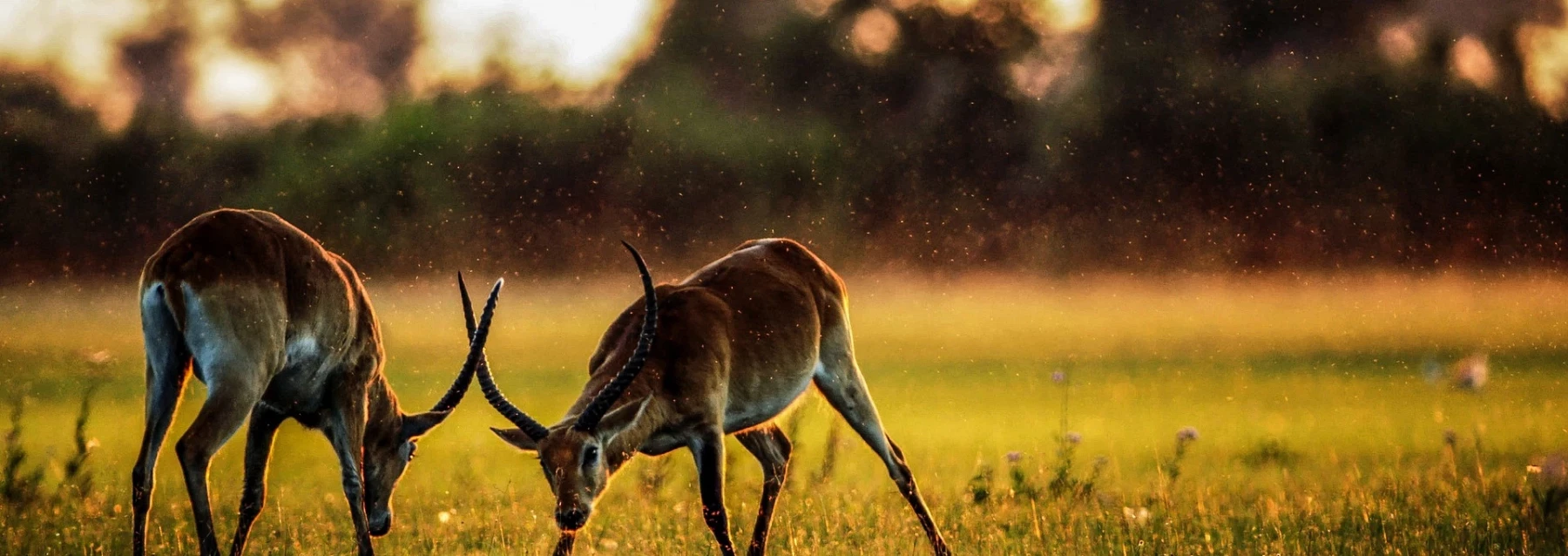Les 10 meilleurs parcs de safaris en Tanzanie
Dernière mise à jour : 26/05/2024 15:39Sommaire
En Tanzanie, les safaris peuvent être réalisés dans différentes régions du pays, chacune offrant des expériences uniques. Voici quelques aspects généraux des safaris en Tanzanie :
-
Migration des Gnous et des Zèbres : Le parc national du Serengeti est renommé pour accueillir l'une des plus grandes migrations animales au monde, où des millions de gnous et de zèbres traversent les plaines en quête de pâturages frais.
-
Cratère du Ngorongoro : Un cratère volcanique abritant une concentration impressionnante d'animaux, y compris les Big Five. Les safaris ici offrent des vues panoramiques spectaculaires.
-
Diversité de la Faune : La Tanzanie abrite une incroyable diversité de faune, y compris des lions, léopards, éléphants, buffles, rhinocéros, girafes, hippopotames, crocodiles, et une variété infinie d'oiseaux.
-
Paysages Variés : Des plaines sans fin du Serengeti aux marais du parc national de Tarangire, en passant par les rives du lac Manyara, les safaris en Tanzanie offrent une variété de paysages à explorer.
-
Opportunités de Safari en Ballon : Certains parcs, comme le Serengeti, offrent des safaris en ballon à air chaud, permettant une vue unique sur la faune et les paysages.
-
Safaris à Pied et en Bateau : Certaines réserves, comme le parc national de Selous, proposent des safaris à pied et en bateau, offrant des perspectives différentes de l'observation de la faune.
-
Cultures Locales : En plus des safaris, la Tanzanie offre également des opportunités de découvrir les cultures locales, en particulier dans les régions avoisinantes où les communautés Maasaï et d'autres groupes ethniques vivent.
Quelle que soit la région que vous choisissez, assurez-vous de planifier votre safari avec des opérateurs fiables et expérimentés pour une expérience sûre et enrichissante.
1 - Parc National du Serengeti
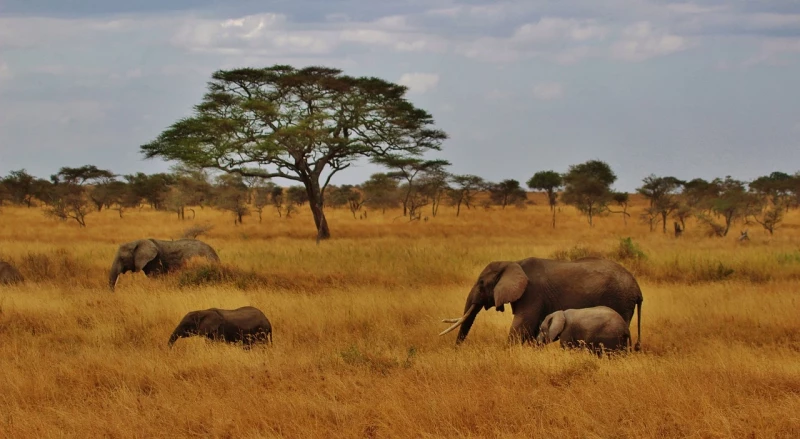
Le Parc National du Serengeti est l'un des parcs nationaux les plus célèbres et emblématiques d'Afrique. Il est situé dans le nord de la Tanzanie et couvre une superficie d'environ 14 750 kilomètres carrés. Le Serengeti est surtout connu pour sa migration annuelle de millions de gnous, de zèbres et d'autres herbivores à travers les vastes plaines, à la recherche de pâturages frais.
Voici quelques points clés sur le Parc National du Serengeti :
-
Migration de la faune : La migration annuelle dans le Serengeti est l'un des plus grands spectacles naturels au monde. Des troupeaux massifs de gnous, de zèbres et d'autres animaux migrent entre le Serengeti et la réserve nationale du Maasai Mara au Kenya à la recherche de nourriture, suivant les cycles de pluie et de sécheresse.
-
Faune diversifiée : Le parc abrite une grande variété d'animaux sauvages, notamment des lions, léopards, éléphants, girafes, buffles, hippopotames, crocodiles, et de nombreuses espèces d'oiseaux. La diversité de la faune est due à la variété des écosystèmes présents dans le parc, tels que les plaines, les bosquets, les collines et les rivières.
-
Patrimoine mondial de l'UNESCO : En raison de son importance écologique et de sa biodiversité exceptionnelle, le Parc National du Serengeti a été désigné site du patrimoine mondial de l'UNESCO en 1981.
-
Activités touristiques : Le Serengeti est une destination prisée pour les safaris, offrant aux visiteurs l'opportunité de voir de près la vie sauvage africaine. Les safaris peuvent être effectués en véhicule tout-terrain, en montgolfière ou même à pied, accompagnés de guides expérimentés.
-
Conservation : Le parc joue un rôle crucial dans la conservation de la faune et la préservation des écosystèmes. Des efforts sont déployés pour lutter contre le braconnage, protéger les habitats naturels et promouvoir la durabilité environnementale.
Le Parc National du Serengeti est un joyau naturel et une destination incontournable pour les amoureux de la nature et les passionnés de safari, offrant une expérience inoubliable au cœur de la vie sauvage africaine.
 Nos astuces pour tirer le meilleur parti de votre expérience.
Nos astuces pour tirer le meilleur parti de votre expérience.
Visiter le Parc National du Serengeti peut être une expérience extraordinaire, mais il est utile de prendre en compte quelques astuces pour maximiser votre séjour et assurer une expérience mémorable. Voici quelques conseils pratiques :
-
Période de migration : Si vous souhaitez assister à la migration spectaculaire des animaux, planifiez votre visite pendant la période de migration, généralement entre décembre et juillet. Cependant, les mois de juin et juillet sont souvent considérés comme les meilleurs pour observer la traversée du fleuve Mara.
-
Réservez à l'avance : Les lodges et les camps dans le parc peuvent être très demandés, surtout pendant la haute saison. Il est recommandé de réserver vos hébergements à l'avance pour garantir la disponibilité.
-
Safaris guidés : Engager un guide expérimenté est fortement recommandé. Les guides locaux connaissent bien la région, la faune, et peuvent vous fournir des informations intéressantes tout en assurant votre sécurité.
-
Emportez des jumelles et un appareil photo : La faune du Serengeti est extraordinaire, et avoir des jumelles et un appareil photo de qualité vous permettra de mieux apprécier et capturer les moments mémorables.
-
Vêtements appropriés : Les températures peuvent varier considérablement, surtout pendant les safaris tôt le matin. Apportez des vêtements légers pour la chaleur de la journée et des couches supplémentaires pour les matinées et soirées plus fraîches. N'oubliez pas un chapeau, des lunettes de soleil et de la crème solaire.
-
Respectez la faune et la flore : Gardez une distance respectueuse des animaux sauvages, ne les dérangez pas, et suivez les règles du parc. Cela garantit la sécurité des visiteurs et la préservation de l'environnement.
-
Préparez-vous pour des trajets en voiture : Les safaris impliquent souvent des trajets en voiture sur des pistes parfois cahoteuses. Assurez-vous d'être à l'aise avec les trajets en véhicule tout-terrain et prenez des précautions si vous êtes sujet au mal des transports.
-
Informez-vous sur la météo : La météo peut varier selon la période de l'année. Informez-vous sur les conditions climatiques avant votre visite pour vous préparer adéquatement.
-
Soyez patient : L'observation de la faune est parfois une question de patience. Restez calme, observez et profitez du paysage.
-
Respectez l'environnement : Suivez les principes du tourisme responsable. Évitez de laisser des déchets, respectez la vie sauvage et contribuez à la préservation de cet écosystème unique.
En suivant ces astuces, vous maximiserez votre expérience au Parc National du Serengeti et créerez des souvenirs inoubliables de la vie sauvage africaine.
2 - Parc national de Selous
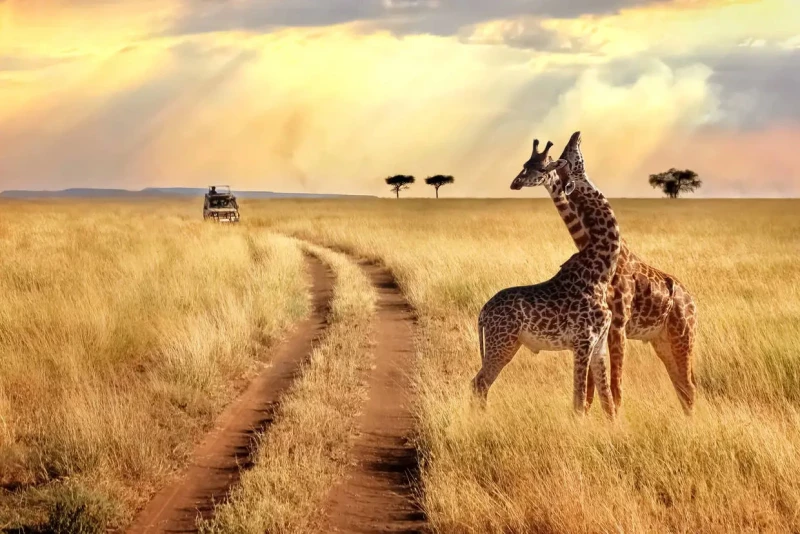
Le Parc national de Selous, également connu sous le nom de Réserve de gibier de Selous, est une vaste aire protégée située dans le sud de la Tanzanie. Voici quelques points clés sur le Parc national de Selous :
-
Taille et Importance : Selous est l'une des plus grandes réserves de gibier d'Afrique, couvrant une superficie d'environ 50 000 kilomètres carrés. En raison de sa taille et de sa biodiversité, la réserve a été inscrite au patrimoine mondial de l'UNESCO en 1982.
-
Écosystèmes Variés : Le parc est caractérisé par une diversité d'écosystèmes, comprenant des plaines, des forêts, des rivières et des lacs. La Rivière Rufiji, qui traverse la réserve, est un élément central de son paysage.
-
Faune Abondante : Selous abrite une grande variété d'animaux sauvages, notamment des éléphants, des buffles, des lions, des léopards, des girafes, des zèbres et de nombreuses espèces d'oiseaux. Il est également connu pour sa population importante de crocodiles et d'hippopotames le long de la Rivière Rufiji.
-
Activités de Safari : Les visiteurs peuvent profiter de safaris en voiture, en bateau ou à pied pour explorer la diversité de la faune et de la flore. Les safaris en bateau sur la Rivière Rufiji offrent une expérience unique en permettant d'observer la vie sauvage depuis l'eau.
-
Conservation : Le Parc national de Selous est engagé dans la conservation de la vie sauvage et de ses écosystèmes. Cependant, il fait face à des défis tels que le braconnage, ce qui a conduit à des efforts accrus pour protéger les espèces en danger.
-
Habitats Uniques : La réserve est également connue pour ses habitats uniques, notamment les collines de Stiegler, qui offrent des vues panoramiques sur la région.
-
Hébergement : Il existe plusieurs camps et lodges dans la réserve, offrant aux visiteurs des options d'hébergement variées, allant du camping au luxe.
-
Accès : L'accès au Parc national de Selous peut se faire par voie terrestre depuis Dar es Salaam ou par avion avec des aéroports régionaux à proximité.
Le Parc national de Selous offre une expérience de safari moins fréquentée par rapport à certaines autres destinations, ce qui en fait une option attrayante pour ceux qui recherchent une immersion plus tranquille dans la nature sauvage de l'Afrique.
 Nos astuces pour tirer le meilleur parti de votre expérience.
Nos astuces pour tirer le meilleur parti de votre expérience.
Visiter la Réserve de gibier de Selous peut être une expérience enrichissante, et voici quelques conseils pour tirer le meilleur parti de votre voyage :
-
Choisissez la Bonne Saison : La meilleure période pour visiter Selous est pendant la saison sèche, de juin à octobre, lorsque la faune se rassemble autour des points d'eau, facilitant ainsi les observations. Cependant, le parc est ouvert toute l'année.
-
Options de Safari : Explorez la réserve à travers une variété d'options de safari, notamment des safaris en voiture, des safaris en bateau le long de la rivière Rufiji et des safaris à pied. Chaque option offre une perspective unique sur la faune et le paysage.
-
Hébergement : Selous propose une gamme d'hébergements, des lodges de luxe aux camps sous tente. Réservez votre hébergement à l'avance, surtout pendant les périodes de pointe, pour garantir les meilleures options.
-
Guides Professionnels : Utilisez les services de guides expérimentés. Ils possèdent une connaissance approfondie de la région, du comportement de la faune et peuvent enrichir votre expérience de safari avec des informations précieuses.
-
Emportez les Articles Appropriés : Apportez des vêtements légers et de couleur neutre pour les activités en journée. De plus, munissez-vous d'un chapeau, de lunettes de soleil, de crème solaire, de répulsif contre les insectes et de chaussures confortables pour les safaris à pied.
-
Jumelles et Appareil Photo : Selous regorge de faune, et avoir des jumelles et un bon appareil photo améliorera votre expérience d'observation de la faune et vous permettra de capturer des moments mémorables.
-
Respectez la Faune : Maintenez une distance sûre et respectueuse des animaux. Évitez de faire du bruit ou des mouvements brusques, et suivez les conseils de vos guides pour assurer la sécurité des visiteurs et de la faune.
-
Restez Hydraté : La Tanzanie peut être chaude, il est donc essentiel de rester hydraté, surtout pendant les safaris en voiture et les promenades. Emportez une gourde réutilisable et buvez beaucoup de liquides.
-
Croisières au Coucher du Soleil : Si possible, envisagez de faire une croisière en bateau au coucher du soleil le long de la rivière Rufiji. C'est une façon pittoresque et paisible d'observer la faune et de profiter de la beauté de la réserve.
-
Apprenez sur la Culture : Profitez de l'occasion pour en apprendre davantage sur la culture locale et les traditions. Certains lodges peuvent proposer des expériences culturelles ou des interactions avec les communautés locales.
-
Précautions de Santé : Consultez votre professionnel de la santé au sujet des vaccinations nécessaires et des précautions de santé avant de voyager en Tanzanie.
-
Tourisme Responsable : Pratiquez un tourisme responsable en respectant les règles du parc, en préservant l'environnement et en soutenant les efforts de conservation. Minimisez votre empreinte écologique et contribuez à la préservation de cet écosystème remarquable.
En suivant ces conseils, vous améliorerez votre expérience lors de la visite de la Réserve de gibier de Selous et contribuerez à la préservation de ce remarquable site naturel.
3 - Parc National de Mikumi
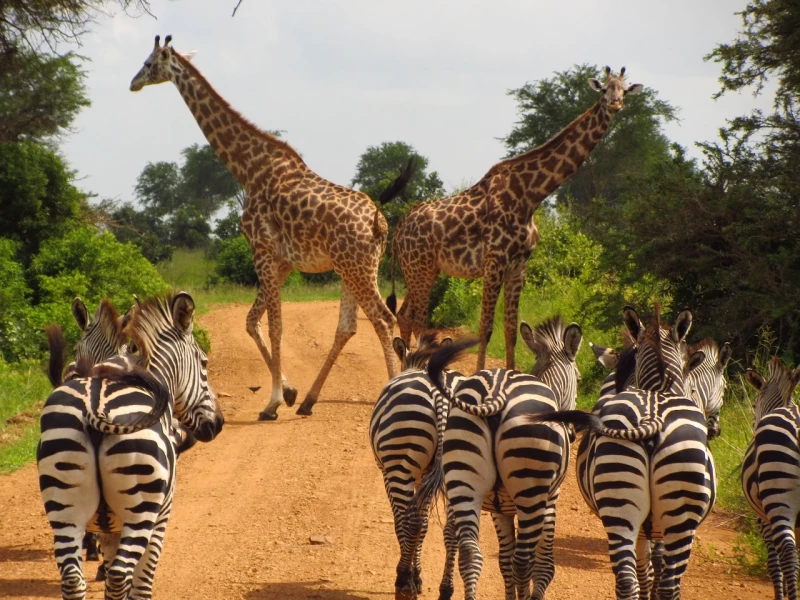
Le Parc National de Mikumi est l'un des parcs nationaux de Tanzanie, situé dans la partie sud du pays, à environ 283 kilomètres à l'ouest de Dar es Salaam. Voici quelques informations clés sur le Parc National de Mikumi :
-
Taille et Emplacement : Le Parc National de Mikumi s'étend sur une superficie d'environ 3 230 kilomètres carrés, ce qui en fait le quatrième plus grand parc national de Tanzanie. Il est bordé par le Parc National de Selous au sud.
-
Faune et Flore : Mikumi est réputé pour sa diversité de faune, y compris des éléphants, des lions, des girafes, des zèbres, des buffles, des crocodiles et de nombreuses espèces d'oiseaux. Les plaines ouvertes du parc permettent des observations faciles de la faune.
-
Écosystèmes Variés : Le parc abrite une variété d'écosystèmes, notamment des plaines ouvertes, des forêts, des collines et la vallée de la rivière Mkata qui traverse le parc.
-
Accessibilité : Mikumi est relativement accessible en voiture depuis Dar es Salaam, ce qui en fait une destination populaire pour les safaris courts ou les excursions.
-
Activités : Les activités dans le parc comprennent des safaris en voiture, des safaris à pied, et des possibilités d'observation des oiseaux. Les véhicules tout-terrain permettent aux visiteurs d'explorer les différentes parties du parc.
-
Hébergement : Il existe plusieurs options d'hébergement dans et autour du parc, allant des camps de safari aux lodges de luxe, offrant aux visiteurs un choix varié en fonction de leur budget et de leurs préférences.
-
Conservation : Le Parc National de Mikumi est engagé dans la conservation de la faune et de la flore locales. Il fait partie de l'écosystème plus vaste du sud de la Tanzanie, qui comprend également la Réserve de gibier de Selous.
-
Climat : Le climat dans la région est généralement chaud, avec des températures élevées pendant la journée. La saison des pluies va de novembre à avril.
-
Observation des Oiseaux : Mikumi est également un endroit populaire pour les amateurs d'ornithologie en raison de la diversité des espèces d'oiseaux présentes dans la région.
Le Parc National de Mikumi offre une expérience de safari authentique, avec la chance d'observer une variété d'animaux sauvages dans un cadre naturel spectaculaire. C'est une excellente option pour ceux qui cherchent à découvrir la vie sauvage tanzanienne tout en évitant les foules plus importantes que l'on peut trouver dans certains autres parcs.
 Nos astuces pour tirer le meilleur parti de votre expérience.
Nos astuces pour tirer le meilleur parti de votre expérience.
Visiter le Parc National de Mikumi peut être une expérience mémorable, et voici quelques conseils pour optimiser votre séjour :
-
Choisir la Bonne Période : La meilleure période pour visiter Mikumi est pendant la saison sèche, de juin à octobre. Pendant cette période, la visibilité est meilleure, et les animaux se rassemblent autour des points d'eau.
-
Safaris Matinaux et Vespéraux : Les animaux sont souvent plus actifs tôt le matin et en fin d'après-midi. Planifiez des safaris à ces moments de la journée pour maximiser vos chances d'observer la faune.
-
Safaris en Voiture : Les safaris en voiture sont le moyen principal d'explorer Mikumi. Assurez-vous de réserver un safari guidé avec un véhicule tout-terrain pour une expérience optimale.
-
Emportez des Jumelles et un Appareil Photo : Les jumelles sont utiles pour observer les détails, et un appareil photo de qualité vous permettra de capturer les moments mémorables de votre safari.
-
Vêtements et Accessoires : Habillez-vous légèrement avec des vêtements de couleur neutre pour vous fondre dans l'environnement. N'oubliez pas un chapeau, des lunettes de soleil, de la crème solaire et des chaussures confortables.
-
Respect de la Nature : Respectez la faune et la flore en maintenant une distance sûre des animaux. Évitez de faire du bruit, ne laissez pas de déchets derrière vous et suivez les conseils des guides.
-
Écoutez les Guides : Les guides locaux sont familiarisés avec le parc et la faune. Écoutez attentivement leurs conseils et informations pour une expérience éducative et enrichissante.
-
Réservez à l'Avance : Si vous prévoyez de séjourner dans le parc ou ses environs, réservez votre hébergement à l'avance pour garantir la disponibilité, surtout pendant la haute saison.
-
Soyez Patient : L'observation de la faune peut demander de la patience. Restez calme, observez attentivement, et soyez prêt à apprécier l'environnement.
-
Connaissances Préalables : Informez-vous sur la faune et la flore que vous pouvez rencontrer à Mikumi avant votre voyage. Cela enrichira votre expérience d'observation.
-
Sécurité : Suivez toutes les règles de sécurité énoncées par les autorités du parc et votre guide. La sécurité est une priorité lors des safaris.
-
Participer à des Activités Guidées : Si possible, participez à des activités guidées telles que des safaris à pied ou des excursions en bateau pour diversifier votre expérience.
En suivant ces astuces, vous maximiserez votre expérience au Parc National de Mikumi et profiterez pleinement de la richesse de la vie sauvage et de la nature environnante.
4 - Cratère de Ngorongoro
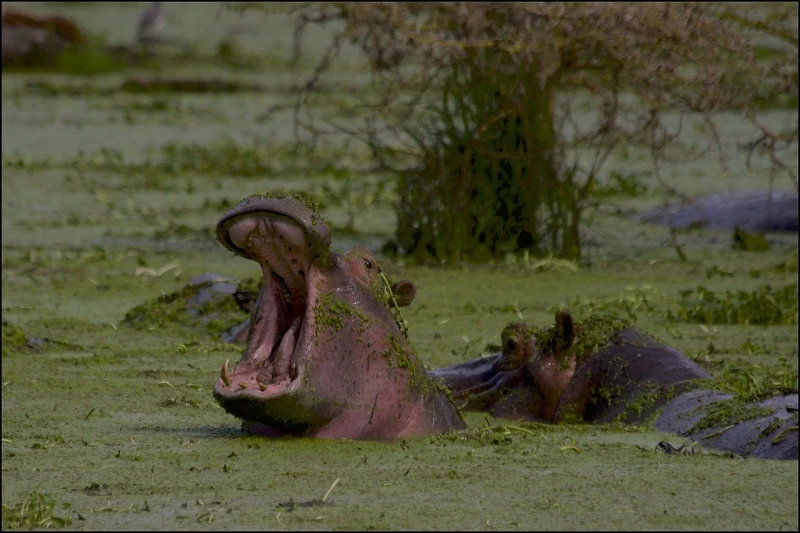
Le Cratère de Ngorongoro est une formation géologique remarquable située dans le nord de la Tanzanie. Voici quelques points clés sur le Cratère de Ngorongoro :
-
Formation Géologique : Le Cratère de Ngorongoro est en réalité le résultat de l'effondrement d'un ancien volcan, formant un cratère massif d'environ 20 kilomètres de diamètre et 600 mètres de profondeur.
-
Patrimoine Mondial de l'UNESCO : En raison de sa beauté naturelle, de sa biodiversité exceptionnelle et de son importance géologique, le Cratère de Ngorongoro a été inscrit au patrimoine mondial de l'UNESCO en 1979.
-
Écosystème Unique : Le cratère crée un écosystème unique avec une grande concentration de vie sauvage. On y trouve une variété d'animaux, notamment des lions, des éléphants, des gnous, des zèbres, des buffles, des rhinocéros, des hippopotames et de nombreuses espèces d'oiseaux.
-
Lac Magadi : Au fond du cratère se trouve le Lac Magadi, une étendue d'eau saline qui attire de nombreux flamants roses, créant ainsi une scène pittoresque.
-
Safaris : Le Cratère de Ngorongoro est une destination populaire pour les safaris en raison de la densité élevée d'animaux et de la relative facilité d'observation due à la topographie du cratère.
-
Conservation : En tant que zone de conservation, le cratère est soumis à des règles strictes pour protéger l'écosystème fragile. Les heures de visite sont limitées, et il est interdit de camper dans le cratère.
-
Population Maasaï : Les communautés Maasaï résident dans les environs du cratère. Leurs troupeaux de bétail coexistent avec la faune sauvage, créant un équilibre unique entre l'homme et la nature.
-
Accès : Le Cratère de Ngorongoro est généralement accessible depuis la ville d'Arusha. Des safaris organisés, des circuits en voiture, et des vols charters sont disponibles pour se rendre dans la région.
Le Cratère de Ngorongoro offre une expérience de safari exceptionnelle avec une concentration élevée d'animaux dans un cadre spectaculaire. C'est l'un des sites incontournables pour les voyageurs passionnés de vie sauvage visitant la Tanzanie.
 Nos astuces pour tirer le meilleur parti de votre expérience.
Nos astuces pour tirer le meilleur parti de votre expérience.
Visiter le Cratère de Ngorongoro peut être une expérience extraordinaire, et voici quelques astuces pour optimiser votre séjour :
-
Heures d'ouverture et de Fermeture : Les heures d'ouverture du cratère sont généralement limitées. Assurez-vous de connaître les heures précises et planifiez votre visite en conséquence.
-
Réservez à l'Avance : Si vous envisagez de faire un safari dans le cratère, il est recommandé de réserver à l'avance, en particulier pendant la haute saison touristique, pour garantir votre place.
-
Guides Locaux : Engagez un guide local expérimenté. Les guides connaissent bien le cratère, la faune et la flore, et ils peuvent fournir des informations intéressantes tout en assurant votre sécurité.
-
Emportez des Jumelles et un Appareil Photo : Les jumelles peuvent être utiles pour observer la faune de plus près, et un appareil photo de qualité vous permettra de capturer les moments mémorables de votre safari.
-
Vêtements et Protection Solaire : Habillez-vous en couches légères et neutres pour le climat. N'oubliez pas un chapeau, des lunettes de soleil et de la crème solaire, car le soleil peut être intense.
-
Respectez les Règles du Parc : Suivez les règles du parc, y compris les restrictions de vitesse et les zones désignées pour les pique-niques. Respectez les indications pour garantir la sécurité des visiteurs et la protection de l'écosystème.
-
Heures de Pointe : Les heures de pointe dans le cratère sont souvent tôt le matin et en fin d'après-midi. Planifiez vos safaris autour de ces périodes pour maximiser vos chances d'observer la faune active.
-
Logement à Proximité : Si possible, choisissez un logement à proximité du cratère pour réduire le temps de trajet et maximiser votre temps d'observation de la faune.
-
Écologie et Environnement : Soyez conscient de l'impact écologique de votre visite. Évitez de déranger les animaux, ne laissez aucun déchet derrière vous, et contribuez à la conservation de cet écosystème fragile.
-
Écoutez les Sons de la Nature : Prenez le temps d'écouter les sons de la nature. Le cratère est souvent rempli de bruits d'animaux, et cette expérience auditive peut être aussi fascinante que l'observation visuelle.
En suivant ces astuces, vous pourrez profiter pleinement de l'incroyable biodiversité du Cratère de Ngorongoro et vivre une expérience de safari exceptionnelle.
5 - Le Parc National d’Udzungwa
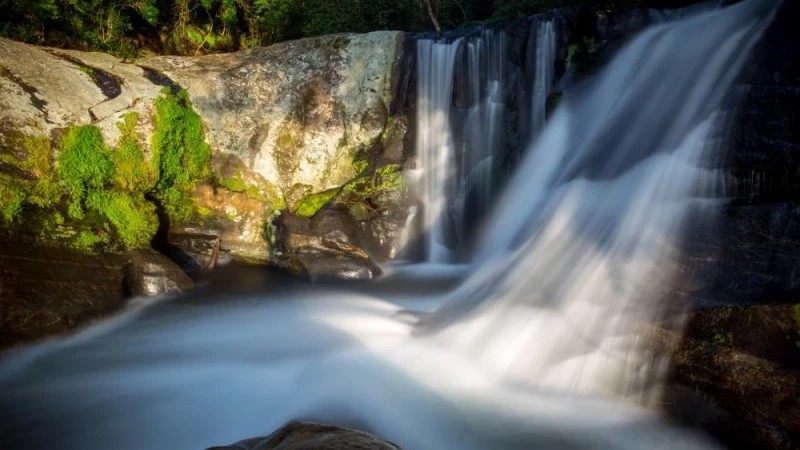
Le Parc National d'Udzungwa est un parc national situé dans les montagnes de l'Est de la Tanzanie. Voici quelques points clés sur le Parc National d'Udzungwa :
-
Biodiversité : Udzungwa est réputé pour sa biodiversité exceptionnelle, abritant de nombreuses espèces endémiques. Le parc est notamment connu pour ses primates, oiseaux et plantes uniques.
-
Montagnes Udzungwa : Le parc est situé dans les montagnes Udzungwa, une chaîne de montagnes isolée et ancienne. Ces montagnes offrent un habitat diversifié, allant des forêts de plaine aux zones de montagne.
-
Cascades et Rivières : Udzungwa est parsemé de cascades pittoresques et traversé par plusieurs rivières. La cascade de Sanje, l'une des plus célèbres, offre une vue spectaculaire sur les environs.
-
Randonnées : Le parc propose plusieurs sentiers de randonnée qui permettent aux visiteurs d'explorer la diversité des paysages et de rencontrer la faune et la flore. La randonnée populaire vers la cascade de Sanje offre une expérience immersive.
-
Faune : Parmi les espèces emblématiques, on trouve le colobe à joues grises d'Udzungwa, une espèce de singe endémique. On peut également rencontrer des éléphants de forêt, des buffles, des léopards, et une variété d'oiseaux colorés.
-
Conservation : Le Parc National d'Udzungwa est crucial pour la conservation des espèces menacées et des écosystèmes de montagne. Il a été créé dans le but de protéger la biodiversité unique de la région.
-
Accès : Le parc est généralement accessible depuis la ville de Mikumi ou Morogoro. Des véhicules tout-terrain sont nécessaires pour atteindre certaines parties du parc.
-
Climat : En raison de l'altitude, le climat dans les montagnes Udzungwa est plus frais que dans les régions environnantes. Les températures peuvent varier, alors il est conseillé d'emporter des vêtements appropriés.
Le Parc National d'Udzungwa offre une expérience de nature préservée, avec des possibilités de randonnée uniques au milieu de paysages montagneux époustouflants et d'une biodiversité remarquable. C'est un endroit idéal pour les amateurs de nature et d'aventure.
 Nos astuces pour tirer le meilleur parti de votre expérience.
Nos astuces pour tirer le meilleur parti de votre expérience.
Visiter le Parc National d'Udzungwa peut être une expérience mémorable, et voici quelques astuces pour optimiser votre séjour :
-
Choisir les Sentiers de Randonnée : Le parc propose plusieurs sentiers de randonnée avec des niveaux de difficulté différents. Choisissez ceux qui correspondent à vos capacités physiques et à vos préférences pour explorer la diversité des paysages et de la faune.
-
Guide Local : Engagez un guide local pour vos randonnées. Les guides connaissent bien le parc, les sentiers, et la faune. Ils peuvent fournir des informations intéressantes et améliorer votre expérience.
-
Cascades et Points de Vue : Assurez-vous d'inclure des sites célèbres tels que la cascade de Sanje dans votre itinéraire. Ces endroits offrent des vues spectaculaires et ajoutent à l'expérience globale.
-
Horaire des Randonnées : Planifiez vos randonnées tôt le matin ou en fin d'après-midi, car c'est souvent à ces moments que la faune est la plus active et que la lumière est optimale pour la photographie.
-
Préparation Physique : Certains sentiers peuvent être exigeants physiquement. Assurez-vous d'être en bonne forme physique avant de vous engager dans des randonnées plus difficiles.
-
Vêtements Appropriés : Portez des vêtements légers et confortables pour la randonnée, mais n'oubliez pas d'apporter une veste légère car les températures peuvent varier en altitude.
-
Hydratation et Collations : Emportez suffisamment d'eau pour rester hydraté tout au long de votre randonnée. Apportez également des collations énergétiques pour maintenir votre énergie.
-
Photographie : Si vous êtes passionné de photographie, assurez-vous d'avoir un appareil photo avec vous pour capturer la beauté des paysages, de la faune et des cascades.
-
Respect de la Nature : Respectez les règles du parc en matière de protection de l'environnement et de la faune. Évitez de perturber les animaux sauvages et gardez les sentiers.
-
Sécurité : Suivez les consignes de sécurité du parc et de votre guide. Soyez conscient de votre environnement et suivez les règles pour assurer votre sécurité.
-
Hébergement : Si vous prévoyez de passer plusieurs jours dans la région, réservez votre hébergement à l'avance, en particulier pendant les périodes de pointe.
En suivant ces conseils, vous serez mieux préparé pour profiter pleinement des merveilles naturelles et de la biodiversité unique du Parc National d'Udzungwa.
6 - Parc National de Ruaha
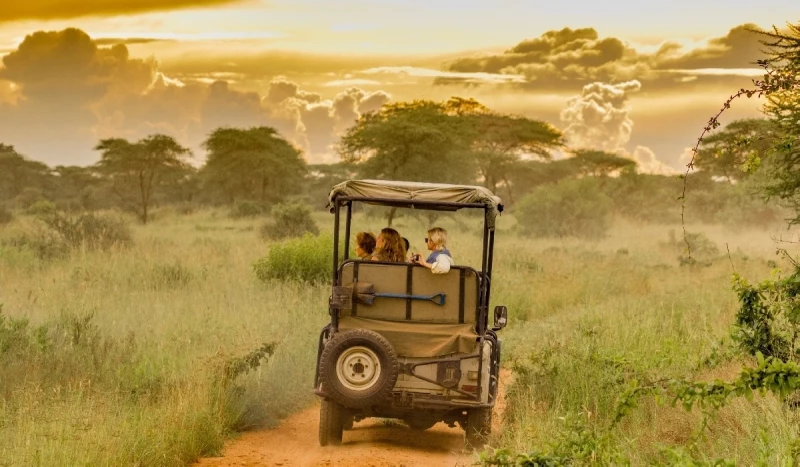
Le Parc National de Ruaha est l'un des parcs nationaux de Tanzanie, situé dans la partie centrale du pays. Voici quelques informations clés sur le Parc National de Ruaha :
-
Superficie et Emplacement : Ruaha est le plus grand parc national de Tanzanie, couvrant une superficie d'environ 20 226 kilomètres carrés. Il est situé dans la région du Centre du pays, à l'ouest de la ville d'Iringa.
-
Écosystème : Le parc englobe une variété d'écosystèmes, notamment des plaines de savane, des collines, des rivières et des forêts. La rivière Great Ruaha traverse le parc, ajoutant à sa diversité biologique.
-
Faune et Flore : Ruaha est réputé pour sa riche diversité de faune, notamment des éléphants, des lions, des léopards, des girafes, des zèbres, des buffles et une variété d'oiseaux. Le parc abrite également des espèces rares telles que le koudou, le lycaon (chien sauvage africain) et le grand koudou.
-
Oiseaux : Le parc est un paradis pour les amateurs d'ornithologie avec plus de 570 espèces d'oiseaux répertoriées, faisant de Ruaha l'un des meilleurs endroits pour l'observation des oiseaux en Tanzanie.
-
Activités : Les activités dans le parc incluent des safaris en voiture, des safaris à pied, et des excursions en bateau sur la rivière Great Ruaha. Les safaris en voiture permettent aux visiteurs d'explorer les vastes étendues du parc.
-
Saisons : La saison sèche, de juin à octobre, est généralement considérée comme la meilleure période pour visiter Ruaha en raison de la concentration d'animaux autour des points d'eau.
-
Hébergement : Il existe plusieurs camps de safari et lodges à l'intérieur et autour du parc, offrant des options d'hébergement allant du camping de brousse au luxe.
-
Conservation : Le Parc National de Ruaha joue un rôle clé dans la conservation de la vie sauvage en Tanzanie. Il est également connecté au Parc National de l'Udzungwa par une zone de corridor, créant un écosystème plus vaste.
Ruaha offre une expérience de safari authentique avec une atmosphère moins fréquentée par les touristes par rapport à certains autres parcs tanzaniens, ce qui permet aux visiteurs de profiter de la nature sauvage dans un cadre plus paisible.
 Nos astuces pour tirer le meilleur parti de votre expérience.
Nos astuces pour tirer le meilleur parti de votre expérience.
Visiter le Parc National de Ruaha peut être une expérience inoubliable, et voici quelques astuces pour optimiser votre séjour :
-
Choisir la Bonne Période : La saison sèche, de juin à octobre, est généralement considérée comme la meilleure période pour visiter Ruaha. Pendant cette période, la visibilité est meilleure, et les animaux se rassemblent autour des points d'eau.
-
Safari Matinal et Vespéral : Les animaux sont souvent plus actifs tôt le matin et en fin d'après-midi. Planifiez vos safaris pendant ces heures pour maximiser vos chances d'observation de la faune.
-
Safari en Voiture : Les safaris en voiture sont le moyen principal d'explorer Ruaha. Assurez-vous de réserver un safari guidé avec un véhicule tout-terrain pour une expérience optimale.
-
Guide Local : Engagez un guide local expérimenté. Les guides connaissent bien le parc, les habitudes des animaux, et peuvent vous fournir des informations enrichissantes pendant vos safaris.
-
Emportez des Jumelles et un Appareil Photo : Des jumelles peuvent vous aider à observer les détails de la faune, et un appareil photo de qualité vous permettra de capturer des moments mémorables.
-
Vêtements et Accessoires : Habillez-vous confortablement avec des vêtements adaptés au climat. N'oubliez pas un chapeau, des lunettes de soleil, de la crème solaire et des chaussures confortables.
-
Respect de la Nature : Respectez la faune et la flore en maintenant une distance sûre des animaux. Évitez de faire du bruit et suivez les conseils de votre guide pour minimiser votre impact sur l'environnement.
-
Réservez à l'Avance : Si vous prévoyez de séjourner dans le parc ou à proximité, réservez votre hébergement à l'avance pour garantir la disponibilité, surtout pendant la haute saison.
-
Découvrez la Vie Nocturne : Certains lodges offrent des activités nocturnes pour observer la faune nocturne. Renseignez-vous sur ces opportunités pour diversifier votre expérience.
-
Restez Calme et Patient : L'observation de la faune peut demander de la patience. Restez calme, observez attentivement, et soyez prêt à apprécier la beauté naturelle qui vous entoure.
-
Participer à des Activités Guidées : Si possible, participez à des activités guidées telles que des safaris à pied pour une expérience plus immersive.
En suivant ces astuces, vous optimiserez votre expérience au Parc National de Ruaha et aurez la chance d'apprécier pleinement la diversité de la vie sauvage de cette région exceptionnelle.
7 - Parc National de Manyara
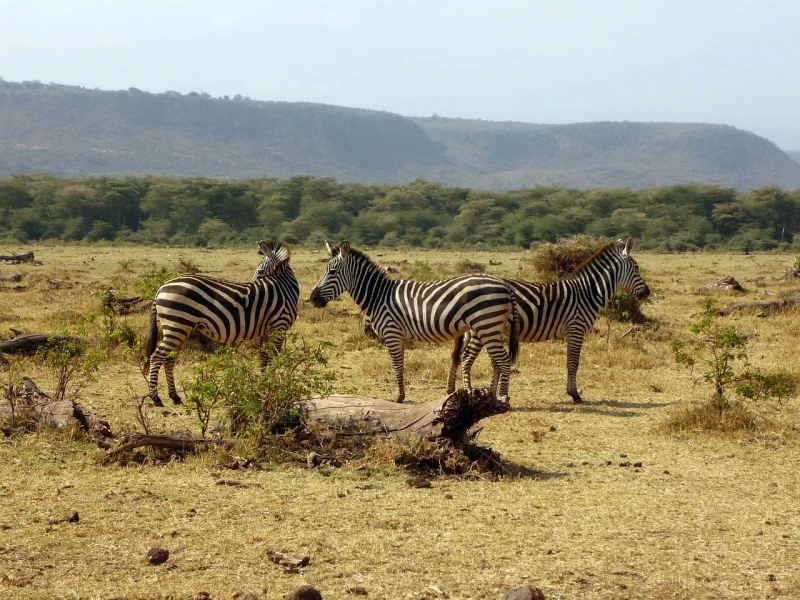
Le Parc National du Lac Manyara est l'un des parcs nationaux emblématiques de Tanzanie, situé dans la vallée du Grand Rift, au nord du pays. Voici quelques informations clés sur le Parc National de Manyara :
-
Taille et Emplacement : Le Parc National de Manyara couvre une superficie d'environ 325 kilomètres carrés et est situé entre les montagnes de l'Escarpement du Rift et le Lac Manyara, dans le corridor de migration des animaux.
-
Lac Manyara : Le lac du même nom est l'une des caractéristiques majeures du parc. Il offre des vues pittoresques et est souvent parsemé de flamants roses, notamment pendant la saison des pluies.
-
Faune et Flore : Bien que relativement petit par rapport à d'autres parcs tanzaniens, le Parc National de Manyara est riche en biodiversité. On y trouve des éléphants, des lions, des girafes, des zèbres, des babouins et une grande variété d'oiseaux, notamment des rapaces.
-
Forêt d'Acacias : Une grande partie du parc est recouverte d'une forêt d'acacias, offrant un habitat propice à la vie sauvage. Les arbres fournissent également de l'ombre aux animaux pendant les journées chaudes.
-
Observation des Oiseaux : Le parc est réputé pour son observation des oiseaux, avec plus de 400 espèces répertoriées. Outre les flamants roses, on peut voir des pélicans, des ibis, des aigles pêcheurs et bien d'autres.
-
Safaris en Voiture : Les safaris en voiture sont la principale activité dans le parc. Les pistes serpentent à travers divers paysages, offrant aux visiteurs des opportunités d'observation de la faune.
-
Activités Culturelles : Certains lodges proposent des activités culturelles, notamment des visites de villages Maasaï locaux, offrant aux visiteurs un aperçu de la vie traditionnelle.
-
Point de Vue de l'Escarpement : Le point de vue de l'Escarpement du Rift offre une vue panoramique spectaculaire sur la vallée du Grand Rift, le lac Manyara et la faune environnante.
-
Éléphants de Manyara : Les éléphants du parc sont connus pour leur comportement unique de grimper dans les arbres pour se nourrir des feuilles d'acacia.
Le Parc National de Manyara est souvent inclus dans les itinéraires de safari en Tanzanie en raison de sa proximité avec d'autres destinations telles que le parc du Serengeti et le cratère de Ngorongoro. Il offre une expérience de safari diversifiée dans un cadre spectaculaire.
 Nos astuces pour tirer le meilleur parti de votre expérience.
Nos astuces pour tirer le meilleur parti de votre expérience.
Visiter le Parc National du Lac Manyara peut être une expérience riche en diversité naturelle, et voici quelques astuces pour maximiser votre séjour :
-
Safari Matinal : Planifiez un safari tôt le matin, lorsque la faune est souvent plus active. C'est également un excellent moment pour observer les oiseaux.
-
Observation des Oiseaux : Apportez des jumelles si vous êtes passionné d'ornithologie. Le parc est réputé pour ses nombreux oiseaux, y compris les flamants roses, les pélicans, les aigles pêcheurs, et bien d'autres.
-
Point de Vue de l'Escarpement du Rift : Ne manquez pas le point de vue de l'Escarpement du Rift pour une vue panoramique spectaculaire sur le lac Manyara et la vallée environnante.
-
Safari en Voiture : Les safaris en voiture sont le moyen principal d'explorer le parc. Assurez-vous d'avoir un guide expérimenté qui connaît bien la région.
-
Observation des Éléphants Grimpeurs : Soyez attentif aux éléphants du parc, qui sont connus pour leur comportement unique de grimper dans les arbres pour se nourrir des feuilles d'acacia.
-
Pique-nique au Hippo Pool : Profitez d'un pique-nique au Hippo Pool, où vous pourrez observer les hippopotames et d'autres animaux tout en vous détendant.
-
Écoutez les Guides : Les guides locaux sont une source précieuse d'informations sur la faune, la flore et la culture locale. Écoutez attentivement leurs commentaires pour enrichir votre expérience.
-
Respect de la Faune et de la Flore : Respectez les règles du parc en matière d'approche des animaux et restez sur les pistes désignées pour minimiser votre impact sur l'environnement.
-
Emportez des Collations et de l'Eau : Ayez des collations légères et de l'eau avec vous pendant le safari pour rester énergique et hydraté.
-
Hébergement à Proximité : Si possible, séjournez dans un lodge ou un camp à proximité du parc pour maximiser votre temps d'observation de la faune.
-
Habillement Approprié : Portez des vêtements légers et neutres, et n'oubliez pas une veste légère pour le matin frais.
En suivant ces astuces, vous serez mieux préparé pour profiter pleinement de la beauté naturelle et de la vie sauvage variée du Parc National de Manyara.
8 - Parc de Saadani
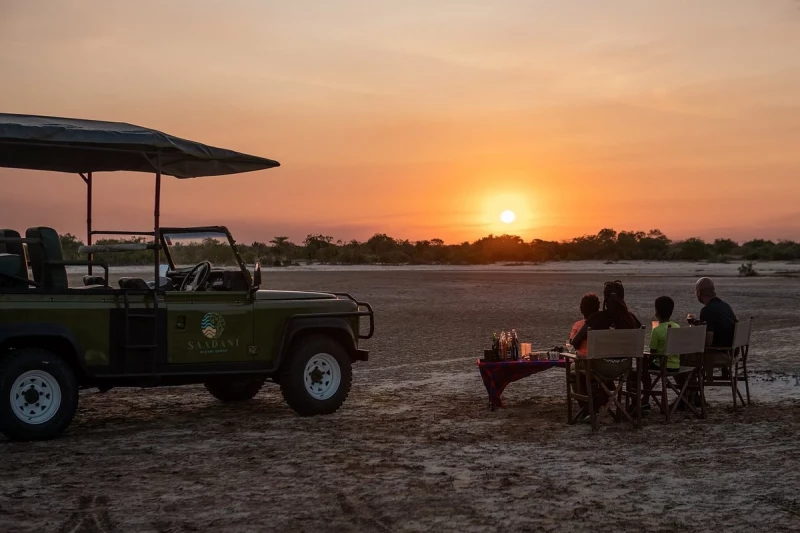
Le Parc national de Saadani est un parc national situé au nord de la Tanzanie, sur la côte de l'océan Indien. Voici quelques informations clés sur le Parc national de Saadani :
-
Emplacement : Le Parc national de Saadani est le seul parc national côtier de Tanzanie. Il est situé dans la région de Pwani, au nord de Dar es Salaam, et offre une combinaison unique de paysages côtiers, de savanes et de forêts.
-
Faune et Flore : Le parc abrite une variété d'animaux sauvages, notamment des éléphants, des lions, des léopards, des buffles, des hippopotames, des crocodiles, des girafes et une multitude d'oiseaux. La combinaison de la faune terrestre et marine est une caractéristique distinctive de Saadani.
-
Écosystèmes Variés : Saadani englobe une diversité d'écosystèmes, allant des plages de sable blanc aux mangroves, en passant par les savanes et les forêts côtières. Cela offre aux visiteurs une expérience de safari unique.
-
Activités : Les activités comprennent des safaris en voiture, des promenades en bateau le long de la rivière Wami, des safaris à pied et des excursions sur les plages de l'océan Indien. Les safaris en bateau permettent souvent d'observer des crocodiles, des hippopotames et une variété d'oiseaux aquatiques.
-
Observation des Oiseaux : Saadani est également un endroit fantastique pour les amateurs d'ornithologie, avec une diversité d'espèces d'oiseaux qui peuplent la région.
-
Séjour à la Plage : Certains lodges et camps de safari offrent des options d'hébergement en bord de mer, ce qui permet aux visiteurs de profiter à la fois des activités de safari et de détente sur la plage.
-
Saison Sèche : La période de juin à octobre, pendant la saison sèche, est souvent considérée comme la meilleure période pour visiter Saadani en raison de la visibilité accrue de la faune.
-
Cultures Locales : Les visiteurs peuvent également avoir l'occasion de rencontrer et d'interagir avec les communautés locales, notamment les pêcheurs et les villages côtiers.
Le Parc national de Saadani offre une expérience de safari unique en intégrant les éléments de la vie sauvage africaine avec les magnifiques paysages côtiers de l'océan Indien. C'est un choix attrayant pour ceux qui souhaitent combiner une expérience de safari traditionnelle avec des activités de plage.
 Nos astuces pour tirer le meilleur parti de votre expérience.
Nos astuces pour tirer le meilleur parti de votre expérience.
Visiter le Parc national de Saadani peut être une expérience unique en raison de sa combinaison de paysages côtiers et de la vie sauvage africaine. Voici quelques astuces pour optimiser votre séjour :
-
Safari en Bateau : Profitez d'un safari en bateau le long de la rivière Wami pour observer les crocodiles, les hippopotames et les oiseaux aquatiques. C'est une excellente façon de découvrir la vie sauvage tout en appréciant les paysages côtiers.
-
Safari Matinal et Vespéral : Planifiez des safaris tôt le matin et en fin d'après-midi, lorsque la faune est la plus active. Les lumières douces du lever et du coucher du soleil offrent également des opportunités de photographie exceptionnelles.
-
Promenade sur la Plage : Profitez des plages de sable blanc de l'océan Indien. Certains lodges offrent un accès direct à la plage, ce qui permet aux visiteurs de se détendre au bord de la mer après des activités de safari.
-
Observation des Oiseaux : Apportez des jumelles pour une observation des oiseaux enrichissante. Saadani est un paradis pour les amateurs d'ornithologie avec une variété d'espèces à observer.
-
Rencontre avec les Communautés Locales : Si possible, participez à des activités culturelles ou visitez les villages locaux pour rencontrer les communautés côtières et en apprendre davantage sur leur mode de vie.
-
Saison Sèche : La période de juin à octobre est souvent considérée comme la meilleure pour visiter Saadani en raison de la visibilité accrue de la faune. C'est la saison sèche où les animaux se rassemblent autour des points d'eau.
-
Séjour en Lodge Côtier : Optez pour un hébergement dans un lodge côtier pour une expérience complète, combinant safari et détente sur la plage.
-
Respect de la Nature : Respectez les règles du parc en matière d'approche des animaux et de protection de l'environnement côtier. Minimisez votre impact sur la nature.
-
Emportez des Collations et de l'Eau : Lors des safaris, ayez des collations légères et de l'eau avec vous pour rester énergique et hydraté.
-
Guide Local : Engagez un guide local expérimenté qui peut partager des connaissances approfondies sur la faune, la flore et la culture locale.
En suivant ces astuces, vous serez prêt à profiter pleinement de la diversité que le Parc national de Saadani a à offrir, allant des safaris passionnants aux moments de détente sur les plages de l'océan Indien.
9 - Parc National de Tarangire
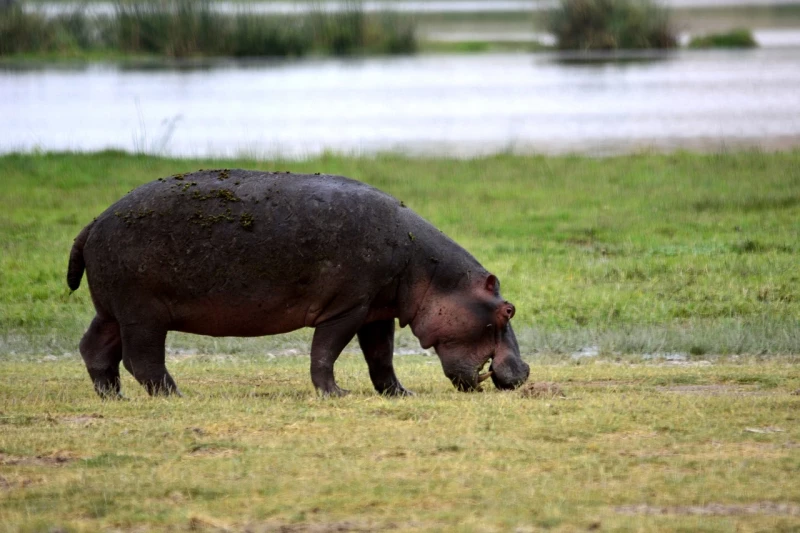
Le Parc national de Tarangire est un parc national renommé situé en Tanzanie, en Afrique de l'Est. Il fait partie du circuit nord des parcs nationaux, aux côtés d'autres destinations célèbres telles que le parc national de Serengeti et la zone de conservation de Ngorongoro. Voici quelques détails clés sur le Parc national de Tarangire :
-
Emplacement : Le Parc national de Tarangire est situé dans la région de Manyara en Tanzanie, à environ 118 kilomètres au sud-ouest d'Arusha, la porte d'entrée du circuit safari du nord.
-
Taille : Le parc couvre une superficie d'environ 2 850 kilomètres carrés (1 100 miles carrés), ce qui en fait le sixième plus grand parc national de Tanzanie.
-
Paysage : Une des caractéristiques distinctives de Tarangire est la rivière Tarangire, qui traverse le parc. Le paysage est diversifié, comprenant des forêts riveraines, des marais, des savanes et de vastes plaines herbeuses. Le parc est particulièrement connu pour ses grands baobabs.
-
Faune : Tarangire est célèbre pour sa grande population d'éléphants, et c'est l'un des meilleurs endroits d'Afrique de l'Est pour observer ces majestueuses créatures. Le parc abrite également une variété d'autres animaux sauvages, tels que des lions, des léopards, des girafes, des zèbres, des gnous, des buffles et de nombreuses espèces d'oiseaux.
-
Avifaune : Le parc est un paradis pour les amateurs d'oiseaux, avec plus de 500 espèces d'oiseaux répertoriées, dont le choucador cendré endémique et le petit perroquet à collier jaune.
-
Migration saisonnière : Pendant la saison sèche (de juin à octobre), de grands troupeaux d'animaux migrent vers la rivière Tarangire à la recherche d'eau, offrant d'excellentes opportunités d'observation de la faune.
-
Activités : Les visiteurs du Parc national de Tarangire peuvent profiter de safaris en voiture, de safaris à pied et d'observation des oiseaux. Le parc est moins fréquenté par rapport à certains des autres parcs du circuit nord, offrant une expérience de safari plus intime.
-
Conservation : Tarangire joue un rôle crucial dans la migration annuelle de la faune en Tanzanie et est une zone importante pour la conservation de la vie sauvage.
-
Accès : Le parc est accessible par la route depuis Arusha, et il y a des pistes d'atterrissage à l'intérieur du parc pour ceux qui arrivent par voie aérienne.
Le Parc national de Tarangire offre une expérience de safari unique et diversifiée, en faisant une destination prisée des amateurs de vie sauvage visitant la Tanzanie.
 Nos astuces pour tirer le meilleur parti de votre expérience.
Nos astuces pour tirer le meilleur parti de votre expérience.
Si vous prévoyez de visiter le Parc national de Tarangire en Tanzanie, voici quelques astuces pour rendre votre expérience plus agréable et enrichissante :
-
Choisissez la bonne saison : La meilleure période pour visiter le parc est pendant la saison sèche, de juin à octobre, lorsque la faune se concentre autour de la rivière Tarangire en quête d'eau. Les animaux sont plus faciles à repérer pendant cette période.
-
Réservez des safaris tôt le matin ou tard l'après-midi : Les températures sont plus fraîches pendant ces périodes, et les animaux sont plus actifs. Les lumières du lever et du coucher de soleil offrent également des conditions idéales pour la photographie.
-
Emportez des jumelles et un appareil photo : La faune et la flore du parc sont extraordinaires, et avoir des jumelles vous permettra d'observer de près les détails. Un appareil photo avec un bon zoom est également essentiel pour capturer des moments inoubliables.
-
Portez des vêtements neutres : Les couleurs vives peuvent effrayer les animaux, alors portez des vêtements aux tons neutres pour vous fondre dans l'environnement et maximiser vos chances d'observation.
-
Restez silencieux et soyez patient : Les bruits forts peuvent perturber les animaux. Éteignez les téléphones et soyez attentif aux sons naturels. La patience est souvent récompensée par des observations intéressantes.
-
Respectez les règles du parc : Suivez les conseils des guides et respectez les règles du parc pour assurer votre sécurité et minimiser votre impact sur l'environnement.
-
Engagez un guide local : Les guides locaux sont bien informés sur la faune, la flore et la culture locale. Engager un guide vous permettra d'obtenir des informations plus détaillées et d'améliorer votre expérience.
-
Soyez conscient de la météo : Même pendant la saison sèche, il peut y avoir des averses inattendues. Apportez des vêtements imperméables et préparez-vous à des conditions météorologiques variables.
-
Préparez-vous physiquement : Les safaris peuvent être fatigants, surtout si vous prévoyez de faire des safaris à pied. Assurez-vous d'être physiquement prêt pour les activités que vous avez l'intention de faire.
-
Réservez votre hébergement à l'avance : Les hébergements dans et autour du parc peuvent être limités, surtout pendant la haute saison. Réservez à l'avance pour garantir votre séjour.
En suivant ces astuces, vous serez mieux préparé pour profiter pleinement de votre visite au Parc national de Tarangire et vivre une expérience de safari mémorable.
10 - Parc National du fleuve de Gombe
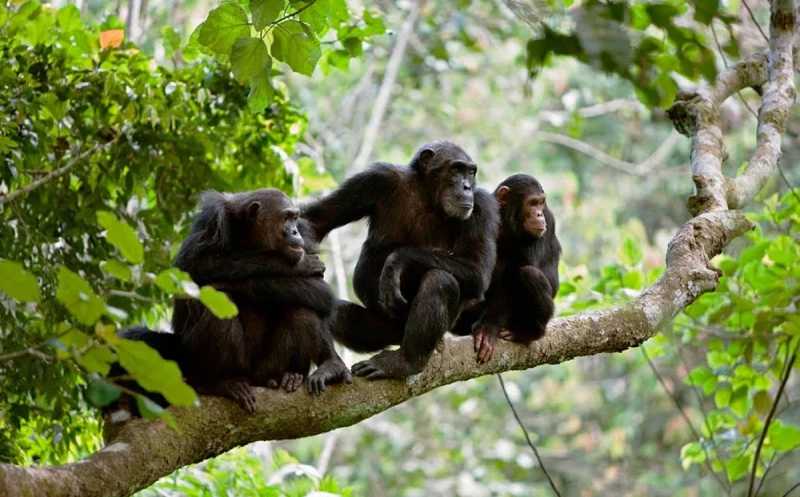
Le Parc national de la rivière Gombe, est un parc national en Tanzanie, célèbre pour son association avec les travaux novateurs de la primatologue Jane Goodall. Voici quelques informations clés sur le Parc national de la rivière Gombe :
-
Emplacement : Le Parc national de la rivière Gombe est situé dans l'ouest de la Tanzanie, près de la frontière avec le Burundi, le long de la rive orientale du lac Tanganyika. Le parc est accessible en bateau ou en petit avion.
-
Taille : Le parc couvre une superficie d'environ 56 kilomètres carrés.
-
Primatologie : La rivière Gombe est particulièrement célèbre pour les recherches à long terme menées par Jane Goodall sur les chimpanzés sauvages. Son travail novateur a commencé au début des années 1960, et le parc est l'un des rares endroits au monde où des chimpanzés sauvages ont été habitués à la présence humaine.
-
Population de chimpanzés : Le parc abrite une population de chimpanzés sauvages habitués, et les visiteurs ont l'occasion unique d'observer et d'étudier leur comportement. Outre les chimpanzés, la Gombe abrite également d'autres primates tels que des babouins olive et des singes colobes rouges.
-
Paysage : Le terrain du parc est composé de vallées abruptes, de collines et de forêts le long des rives du lac Tanganyika. La combinaison de la forêt tropicale et du cadre lacustre fait du Parc national de la rivière Gombe une destination pittoresque.
-
Avifaune : La Gombe abrite diverses espèces d'oiseaux, et le lac lui-même soutient une vie aquatique variée.
-
Activités : L'activité principale à la Gombe est la randonnée pour observer et interagir avec les chimpanzés. De plus, les visiteurs peuvent profiter des sentiers de randonnée dans le parc, de l'observation des oiseaux et de sorties en bateau sur le lac Tanganyika.
-
Conservation : Le parc est crucial pour la conservation des chimpanzés et de leur habitat. Des efforts de conservation sont en place pour protéger à la fois les primates et l'environnement environnant.
-
Hébergement : Il existe des hébergements de base dans le parc, offrant aux visiteurs la possibilité de rester à proximité de l'habitat des chimpanzés.
Il est conseillé de vérifier les mises à jour éventuelles ou les changements dans les réglementations, les hébergements ou d'autres détails avant de planifier une visite,
 Nos astuces pour tirer le meilleur parti de votre expérience.
Nos astuces pour tirer le meilleur parti de votre expérience.
Si vous envisagez de visiter le Parc national de la rivière Gombe en Tanzanie, notamment pour observer les chimpanzés, voici quelques astuces pour rendre votre expérience plus agréable et enrichissante :
-
Organisez votre permis à l'avance : Assurez-vous d'obtenir les permis nécessaires pour visiter le parc et observer les chimpanzés. Il est généralement recommandé de réserver ces permis à l'avance.
-
Engagez un guide local : Les guides locaux sont familiarisés avec le comportement des chimpanzés et les meilleurs endroits pour les observer. Leur expertise peut grandement améliorer votre expérience.
-
Respectez les règles de suivi des primates : Il est important de suivre les règles établies pour l'observation des chimpanzés afin de minimiser la perturbation de leur comportement naturel. Ces règles peuvent inclure des directives sur la distance à maintenir et le comportement à adopter.
-
Portez des vêtements neutres : Comme avec d'autres observations de la faune, il est conseillé de porter des vêtements aux couleurs neutres pour éviter d'effrayer les animaux.
-
Soyez préparé physiquement : La randonnée pour observer les chimpanzés peut être exigeante physiquement. Assurez-vous d'être en bonne forme physique et portez des chaussures confortables.
-
Apportez des jumelles et un appareil photo : Les jumelles vous permettront de voir de près les détails, et un appareil photo avec un bon zoom sera essentiel pour capturer des souvenirs de votre rencontre avec les chimpanzés.
-
Soyez patient : L'observation des chimpanzés peut prendre du temps. Soyez prêt à être patient et à rester silencieux pour maximiser vos chances de voir des comportements intéressants.
-
Respectez l'environnement : Suivez les principes du tourisme durable en évitant de laisser des déchets et en respectant la faune et la flore locales.
-
Vérifiez les conditions météorologiques : Assurez-vous de consulter les conditions météorologiques avant votre visite. La météo peut influencer les déplacements et les activités des chimpanzés.
-
Prévoyez du temps supplémentaire : Les observations de la faune sont parfois imprévisibles. Prévoyez du temps supplémentaire dans votre emploi du temps au cas où les chimpanzés seraient difficiles à localiser.
-
Soyez conscient des règles du parc : Informez-vous sur les règles spécifiques du parc et assurez-vous de les respecter pour la sécurité des visiteurs et la préservation de l'écosystème.
En suivant ces astuces, vous augmenterez vos chances de profiter pleinement de votre visite au Parc national de la rivière Gombe et de vivre une expérience mémorable d'observation des chimpanzés.
Les meilleurs parcs de safaris - Où Loger ?
Lorsque vous planifiez un safari en Tanzanie pour visiter les meilleurs parcs, il est important de choisir des hébergements stratégiquement situés pour faciliter vos déplacements vers les parcs nationaux. Voici quelques endroits populaires pour se loger en fonction des principaux parcs de safari :
-
Arusha : Arusha est souvent le point de départ des safaris en Tanzanie en raison de sa proximité avec le Kilimandjaro et de son accès aux parcs du nord, notamment le Serengeti, le Ngorongoro et le lac Manyara.
-
Parc national du Serengeti : Séjournez dans des camps ou lodges situés à l'intérieur ou aux abords du parc pour maximiser votre temps d'observation des animaux pendant la Grande Migration. Les zones comme Seronera et la région de Grumeti sont populaires.
-
Cratère du Ngorongoro : Les logements près du cratère offrent des vues spectaculaires. Certains lodges sont situés sur le bord du cratère, tandis que d'autres se trouvent dans les environs.
-
Parc national de Tarangire : Choisissez des hébergements à proximité du parc pour minimiser le temps de trajet. La région de Tarangire offre divers lodges et camps.
-
Parc national de Manyara : Des logements situés à proximité du parc national du lac Manyara vous permettront de profiter pleinement de la diversité des paysages et de la faune de cette région.
-
Parc national de Selous : Pour Selous, logez dans des camps ou lodges situés dans la réserve elle-même pour une expérience immersive. La rivière Rufiji est une zone particulièrement populaire.
-
Arusha/Moshi pour le Kilimandjaro : Si vous envisagez de grimper le Kilimandjaro en plus de faire un safari, rester à Arusha ou Moshi est pratique.
Assurez-vous de réserver vos hébergements à l'avance et de tenir compte des recommandations d'opérateurs de safari expérimentés. Ils peuvent vous aider à organiser votre itinéraire pour maximiser votre expérience de safari en Tanzanie.
Les meilleurs parcs de safaris - Comment se déplacer ?
Pour vous déplacer et visiter les meilleurs parcs de safari en Tanzanie, vous avez plusieurs options de transport. Le choix dépend de divers facteurs tels que votre budget, le temps que vous avez à disposition, et vos préférences en matière de confort. Voici quelques moyens de transport courants pour explorer les parcs de safaris :
-
Vols intérieurs : La Tanzanie dispose de nombreux aéroports régionaux. Prendre des vols intérieurs peut être une option rapide et pratique pour se rendre d'un parc à l'autre, surtout si vous visitez des parcs éloignés comme le Serengeti, Selous, ou le Ruaha.
-
Véhicule privé avec chauffeur-guide : C'est l'option la plus courante pour les safaris. Vous pouvez louer un véhicule tout-terrain avec un chauffeur-guide expérimenté. Ces guides connaissent bien la région, la faune et peuvent vous offrir des informations détaillées sur la vie sauvage.
-
Safaris en groupe : Rejoindre un safari en groupe organisé peut être une option plus économique. Les groupes utilisent généralement des véhicules spécialement équipés pour les safaris et incluent un guide professionnel.
-
Véhicule de location : Si vous préférez une plus grande autonomie, vous pouvez louer un véhicule et conduire vous-même. Assurez-vous de choisir un véhicule adapté aux conditions du safari, comme un 4x4.
-
Transferts organisés : Certains lodges et camps proposent des transferts organisés entre les parcs. Cela peut être une option pratique si vous réservez un forfait safari avec des hébergements spécifiques.
-
Bus et transports publics : Les transports en commun sont moins courants pour les safaris, mais il peut y avoir des bus ou des navettes entre certaines destinations. Cependant, cela peut ne pas être l'option la plus pratique pour les parcs éloignés.
-
Safaris en ballon : Dans certaines régions, comme le Serengeti, des safaris en ballon à air chaud sont également proposés, offrant une vue panoramique exceptionnelle sur la faune et le paysage.
Avant de choisir votre moyen de transport, assurez-vous de planifier votre itinéraire, de tenir compte des distances entre les parcs et de consulter des opérateurs de safari locaux pour des conseils personnalisés en fonction de vos besoins et préférences.
Les meilleurs parcs de safaris - Meilleure période
La Tanzanie est une destination de safari populaire toute l'année, mais il y a des périodes spécifiques qui peuvent être plus propices à certaines expériences, en particulier en ce qui concerne la Grande Migration dans le parc national du Serengeti. Voici quelques éléments à prendre en compte lors de la planification d'un safari en Tanzanie :
-
Grande Migration dans le Serengeti :
- Juin à juillet : C'est la période de la Grande Migration dans la région occidentale du Serengeti, avec des millions de gnous et de zèbres traversant la rivière Grumeti.
- Juillet à septembre : La migration continue vers la région nord du Serengeti, avec la traversée de la rivière Mara à la frontière avec le Kenya.
-
Meilleure période pour l'observation de la faune :
- De juin à octobre : Pendant la saison sèche, l'herbe est plus courte, facilitant l'observation des animaux. Les animaux se regroupent près des points d'eau, ce qui rend l'observation plus facile.
-
Naissances d'animaux :
- De janvier à février : C'est la période des naissances pour de nombreux animaux dans la région du Ndutu, située au sud-est du Serengeti.
-
Période des pluies (avril et mai) :
- Bien que cette période soit moins populaire en raison des pluies, certaines régions, comme le parc national du Tarangire, peuvent être très vertes et propices à l'observation des oiseaux.
-
Climat général :
- De juin à octobre : Période sèche et fraîche, avec des températures agréables.
- De novembre à mai : Période des pluies, avec des températures plus chaudes.
-
Festivals culturels :
- Si vous êtes intéressé par les festivals et la culture locale, certaines tribus, comme les Maasaï, célèbrent divers événements tout au long de l'année.
En résumé, la période idéale pour un safari en Tanzanie dépend de vos préférences spécifiques. Les mois de juin à octobre sont généralement recommandés pour l'observation de la faune, tandis que la période de la Grande Migration est particulièrement captivante en juin et juillet. Assurez-vous de vérifier les conditions spécifiques de chaque parc que vous prévoyez de visiter et consultez un opérateur de safari pour des conseils personnalisés en fonction de vos intérêts.
